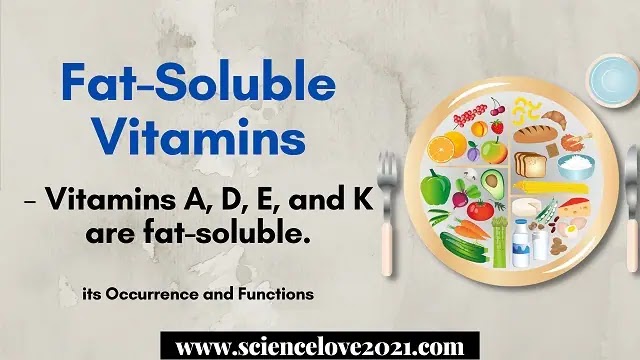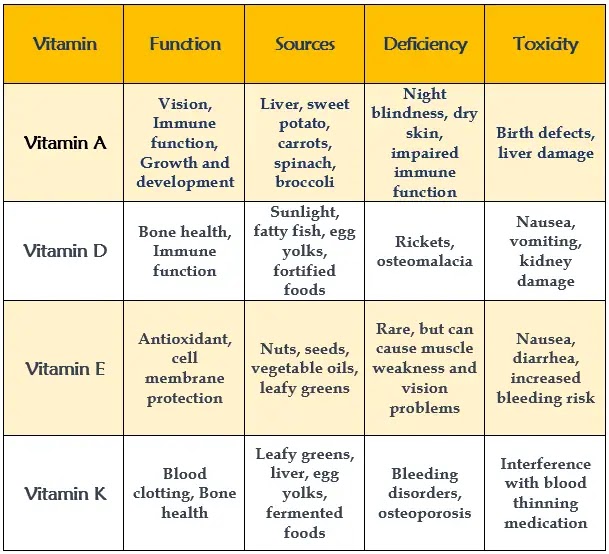The fat soluble vitamins are always associated with the lipids of the natural foods. Vitamins A, D, E and K belong to this group. Their distribution is varied as their function. They are stored mainly in liver.
(1) Vitamin-A (Retinal)
Occurrence : We get vitamins from milk, cheese, butter, egg yolk, liver, meat, fish oil, etc. In fact, it is found in our bodies as well as those of other animals. It is formed mainly in the cells of the liver and intestinal mucosa, from carotenoid pigments obtained from carrots and other yellow and dark green vegetables, red, yellow or orange colored fruits and plums, oranges etc.
It is generally believed that carotenoids, are present in both plant and animal tissues, whereas vitamin A occurs in animal tissues only. It is also believed that the carotenoids found in animals are derived from the plants as food source and in animals these carotenoids are converted into vitamin A by some process.
It is generally believed that carotenoids, are present in both plant and animal tissues, whereas vitamin A occurs in animal tissues only. It is also believed that the carotenoids found in animals are derived from the plants as food source and in animals these carotenoids are converted into vitamin A by some process.
It had not been ruled out that carotenoids may develop in animal organisms. The chief source of provitamin A (Carotenoids) are green vegetables like spinach, cabbage, and beet green and yellow coloured vegetables and fruits, like- corn, sweet potatoes, carrots, tomatoes, yellow peaches etc.
Vitamin A is soluble in fats and solvents but insoluble in water. It is stable at high temperatures but unstable in air because it is destroyed by ultraviolet light. The stability of the Vitamin can be produced by the addition or antioxidants like hydroquinone or a-tocopherol (Vitamin E).
Vitamin A comes from some colorful things found in nature called carotenoids. These carotenoids are yellow or red, and the most important ones for making vitamin A are alpha-carotene, beta-carotene, and gamma-carotene. They're called "provitamin A". When we eat these carotenoids, our body changes them into vitamin A in the intestines, but we don't really know how this happens. One of these carotenoids is called "Cryptoxanthin". It's a type of beta-carotene with a special name: "monohydroxy β-carotene (C40H55OH)".
- The maintenance of the integrity of epithelial tissue is an important function of a vitamin A. in its absence, normal secretary epithelium is replaced by a dry, keratinized epithelium which is more susceptible to invasion by infectious organisms.
- It is essential to growth, particularly of skeleton and other connective tissue.
- Most vertebrates have retinas that have visual components made up of rods and cones, two different types of light sensors. The rods are concerned with vision in dim light (night vision) and the cones are the organs of vision in bright light (day vision) and of colour vision.
- It prevents infection.
- Vitamin A helps in keeping normal fertility.
Deficiency: The deficiency of Vitamin A causes:
- Night blindness (nyctalopia) which is a disturbance of rod vision, is one manifestation of vitamin a deficiency.
- Xerophthalmia, i.e., Keratinization of ocular which may progress to blindness, is a late result of vitamin A deficiency, Xerophthalmia is a major cause of blindness in childhood.
- In the absence of vitamin A, the growth of animals does not progress normally. The skeleton is affected first, and then the soft tissues.
- In the growing animal, collagenous tissues are particularly affected by a deficiency of vitamin A.
(2) Vitamin-D (Ergocalciferol or Antirachitic Vitamin)
Vitamin D is a fat soluble vitamin. It is present naturally in very few foods. However, it is synthesized endogenously when the ultra-violet rays (UV-B) of the sun strike the skin and trigger synthesis of vitamin D from 7-dehydro cholesterol.
In animals which have long furs and the birds having thick feathers, the UV-rays do not reach the skin. In such cases an oily secretion from the skin is deposited on the fur. The UV-rays reaching the fur generate vitamin D from these secretions which is obtained orally during grooming.
Vitamin D, is commonly known as calciferol. There are, however, several forms of vitamin D. out of which only two D2 or D3 are more important.
None of these forms is physiologically active. The active form calciferol is obtained after some processing (hydroxylation) in liver and kidney.
The first hydroxylation takes place in the liver where vitamin D3 is converted to calcidol (25-hydroxy cholecalciferol).
The second hydroxylation takes place in kidney, converting calcidol to calcitriol (1, 25-dihydroxy cholecalciferol).
Functions: The active form of Vitamin D, the calcitriol, binds to its receptor protein in the target cells. The receptors are present in the nuclei. Calcitriol binds the receptors and activities them to function as transcription factor which affects expression of genes for such transport proteins which are involved in absorption of calcium in the small intestine. These activated receptors are expressed in most of the organs and also maintain the calcium and phosphorus levels in the blood.
Deficiency Symptoms: Vitamin D deficiency leads to variety of diseases and ultimate death.
- Rickets: A childhood disease when the bones become thin, brittle and mis-shapen due to improper calcium availability and bone growth under deficient vitamin D conditions.
- Osteomalacia: An exclusively adult disease when the bones become thinner, proximal muscles are weak and bones become fragile.
- Osteporosis: Reduced mineral (calcium) density in the bones and increased bone fragility. A disease more common in adults specially in ladies.
- Cancer: Vitamin D deficiency increases the chances of a variety of cancers (colon cancer, pancreatic cancer and breast cancer.
- Cardiovascular: Vitamin D deficiency is also associated with an increase in high blood pressure and cardiovascular risks. It may also be associated with hypertension, high VLDL and impaired insulin metabolism.
- Infectious disease: Vitamin D deficiency often leads to reduced immunity causing an increased risk of infection such as influenza and tuberculosis.
(3) Vitamin-E (Tocopherol)
Occurrence: Vitamin E is of wide occurrence in plants as well as in animals. α-Tocopherol is most abundant. The rich natural resources are vegetables fats; e.g., wheat germ oil, cotton seed oil, corn oil, peanut oil, and other seed-germ oils. In considerable amounts it is found in all green plants; e.g, lettuce, and alfalfa. Animal tissues contain relatively small amounts, e.g., fish-liver oil, egg yolk, animal fats, milk of cow and human, and muscles of heart and kidney.
Function of vitamin E
(4) Vitamin-K
Function of vitamin E
- The antioxidant action, of tocopherols is responsible for its spraying action on Vitamin A and carotene, which are particularly sensitive to oxidation destruction in the presence of unsaturated fats.
- In vitro, vitamin E controls the O2 uptake of muscles and body fat.
- Tocopherols prevent due to highly unsaturated fatty-acids in rats and chicks.
- In rats, tocopherols prevent the massive hepatic necrosis caused by feeding certain brand of yeast.
- Vitamin E also prevents the liver injury induced by feeding excessive amounts of Cod-liver oil.
- In chicks, the administration of tocopherols prevents the development of "encephalomalacia (cerebellar disorder)" and an "exudative diathesis".
- The tocopherols' activity protects sensitive mitochondrial systems from irreversible inhibition by lipid peroxides.
(4) Vitamin-K
Occurrence: All forms of vitamin K are derivatives of 2-methyl 1, 4-naphthoquinone. The aliphatic side chain (isoprenoid) attached to position 3 in the ring is variable and that makes different types of vitamin K - Vitamin K1, known as phylloquinone contains a phytyl side chain of four isoprenoid residues one of which is unsaturated. The other vitamins K2, known as menaquinone has a variable number of isoprenoid residues.
It is a fat soluble vitamin and is obtained mainly through green vegetables (spinach, cabbage, cauliflower, and broccoli). Phylloquinones are bond tightly to the thylakoid membrane in chloroplasts and, therefore, are available in low quantity. However, when the vegetables are cooked in fat the bioavailability increases three fold in spinach.
It is a fat soluble vitamin and is obtained mainly through green vegetables (spinach, cabbage, cauliflower, and broccoli). Phylloquinones are bond tightly to the thylakoid membrane in chloroplasts and, therefore, are available in low quantity. However, when the vegetables are cooked in fat the bioavailability increases three fold in spinach.
Mena quinine-4 is synthesized by animals and is found in meat, egg and milk while menaquinone-7 (MK-7) is synthesized by bacteria (gut flora).
Vitamin K was discovered by German scientists in 1929. Later its structure and chemical nature was given by Edward Adelbert Dois.
Functions: The chief functions of vitamin K are:
- Formation of proconvertin,
- plasma thromboplastin,
- Stuart's factor
- prothrombin by hepatic cells.
- Cell-metabolism
- It participates in electron transfer in the oxidative chain
- Vitamins K is associated with phosphorylations,
- It plays an important role in the coupling mechanisms.
Deficiency Symptoms: Vitamin K deficiency in normal conditions are rare because it is easily available from diet and also the gut-flora synthesizing it. However, diseased or alcoholics may show deficiency symptoms. The important symptoms are heavy menstrual bleeding in women, anemia, bleeding of the gums and nose.
table of fat soluble vitamin




No comments:
Post a Comment